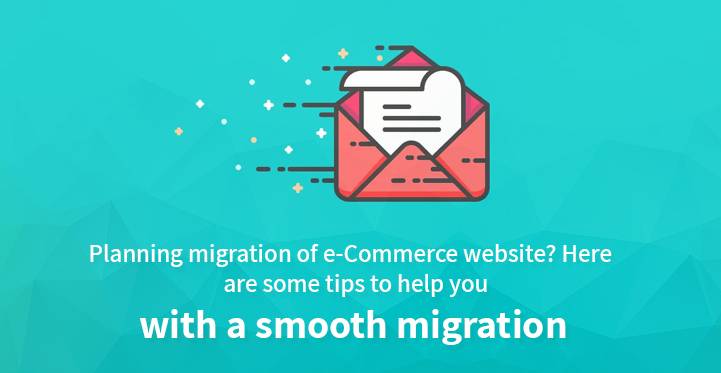Migration of e-Commerce Website
If you have decided on the migration of e-commerce website, you are most probably already familiar with this.
Table of Contents
When you migrate any website, it is never easy. Same is the case with an e-commerce website. You have to keep in mind the challenges that are going to come in the way of this migration as this is a very tricky task.
When you are planning on the movement, there will be roadblocks and issues regarding which you need to be careful..
Why would you even want a migration in the first place? This is the first and foremost question to answer.
The movement may be to opt for a platform that is more promising in terms of managing your increasing needs – a newer, better, and faster platform.
However, before you make any finalizing decision, there are a lot of checks that need to be made.
One of the biggest concerns when deciding a migration plan is to choose between an open-source and a commercial tool.
This concern is a significant dilemma to work consider.
A lot of factors need to be found here. These include but are not limited to payment plans or ERP and order management. Deciding upon these factors will result in the best-suited tool for your website.
In this relation, we have picked up HubSpot to WordPress Migration solutions that work seamlessly with any WordPress-based template or website.
Another significant and quite surprising factor to consider when planning a migration is the market that is targeted.
Flexibility is necessary for the technology because it affects the volume of the customer base, and also another reason is the tool itself with its ability to manage local news.
This local news consists of the delivery time, the time required for shipment together with the cost, the sales tax and consideration of VAT, etc.
A very decisive factor is the tool’s ability to provide a multi-channel experience supporting multiple currencies and locations. The better players in the e-commerce space are those that offer advanced price optimization, data mining, and analytical capabilities.
Simple Steps to Migration of e-Commerce Website
First of all, let us take a quick look at how migration takes place.
The following is the list of steps that you need to follow to help in the movement of your website generally.
Summarizing a migration:
- Choose a platform that works best for the business you have.
- Send the request for Proposals to the finalists.
- Make a forecast for your Revenues.
- Map out third-parties and Integration.
- Get inputs from all of the stakeholders and then test out the platform.
- Start launching the migration of your e-commerce website.
- For testing, relaunch your website.
- It is finally done. Time to go Live!
Now that we know how it is generally done, its time to dig deeper and understand how the planning process takes place.
Create a deployment a calendar:
Planning a migration of e-commerce website cannot be carried out as a single function. There are various functions like IT, sales, finance, customer service, marketing, and operations that need to be involved in the migration to take place.
Multiple stakeholders coming from various departments need to make sure that delays are not an option, especially when they have a part by working together and understanding the migration process completely.
Change might be required for business processes:
With a faster and newer platform being introduced, the automated processes might start to increase, and the manual may be decreased. As a result, there might be a need for you to revise your business processes to keep them up to the mark. However, it is not enough to only change the business processes.
These processes have to be tested thoroughly by those who them. It is necessary to set up the new e-commerce website’s functionality and framework according to the desired plugins. The processes in work have to be tested and validated by the organization to check the amount of custom coding that is required.
Taking Search Engine Optimization (SEO) into consideration:
When planning the to new server WordPress migration of e-commerce website, we need to understand the fact that newly migrated websites often drop in their rankings.
To avoid this dip in the ranking for the site, we need to properly plan the migration with an SEO expert who can help us out by keywords, etc. to lower the effect of the movement.
For example, in cases where there is a URL change, the 301 redirects will make sure that maximum traffic is retained and there is link popularity.
We also have a helpful article regarding migration of website without hurting SEO.
Setting up of metrics:
After the migration of e-commerce website is completed, there needs to be a check on how successful the movement was. To keep a check, you need to specify several parameters either for the successor for the failure.
The stakeholders shall decide to identify the most crucial factors that will be the basis of judgment for whether the migration was a failure or a success.
Training of your users:
Admittedly, we all know that the hardest part of any change is the acceptance of the change. Usually, the employees in any organization are not a big fan of changes, and they resist it. However, if the employees are provided with a thorough training program. There will be a higher acceptance of the difference in the platform.
Let me tell you a golden rule here. Make sure the training sessions are regular and a little early to keep up the excitement for the change among the employees.
Summing it all up:
Looking for someone to help you plan migration of an e-commerce website? Need help to make a smoother transition? Indeed, the most essential thing that you need to seek is help from a solution provider for WordPress development that covers all the points as mentioned above.
So go ahead and properly plan your transition so that it does not affect your ratings and help you perform better at the newer platform that you have chosen for your site, wither an open-source or a commercial one. Good Luck with the migration!



